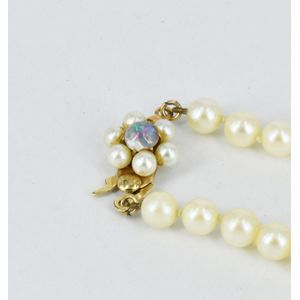Ivory and Netsuke Necklace Set
An ivory bead and netsuke necklace by Carol L Brooks, strung as a long necklace of round polished ivory beads, varied in size, further detailed by pale pink hardstone beads and silver rondelles, featuring to one side a carved netsuke of a young girl with applied polychrome detail, signed by artist Carol L Brooks, fitted with silver clasp. Presented with matched drop earrings fitted with pierced silver hooks
You must be a subscriber, and be logged in to view price and dealer details.
Subscribe Now to view actual auction price for this item
When you subscribe, you have the option of setting the currency in which to display prices to $Au, $US, $NZ or Stg.
This item has been sold, and the description, image and price are for reference purposes only.
- Polychrome - Made or finished in many colours. For furniture, it is used to indicated a painted finish.
- Hardstone - Hardstone is not a scientific name for a particular gemstone, but a word used to describe any one or more semi-precious stones used in jewellery and decorative arts, and can include jade, agate, onyx, rock crystal, amber, jet and carnelian. Softer stones and minerals such as soapstone, and alabaster and hard stones used in building such as marble or granite are generally excluded.
- Ivory - Ivory is a hard white material that comes from the tusks of elephants, mammoth, walrus and boar, or from the teeth of hippopotamus and whales. The ivory from the African elephant is the most prized source of ivory. Although the mammoth is extinct, tusks are still being unearthed in Russia and offered for sale.
Ivory has been used since the earliest times as a material for sculpture of small items, both in Europe and the east, principally China and Japan.
In Asia ivory has been carved for netsuke, seals, okimono, card cases, fan supports, animals and other figures and even as carved tusks.
In the last 200 years in Europe ivory has been used to carve figures, for elaborate tankards, snuff boxes, cane handles, embroidery and sewing accessories, in jewellery and as inlay on furniture. Its more practical uses include being used for billiard balls, buttons, and a veneers on the top of piano keys.
The use and trade of elephant ivory have become controversial because they have contributed to Due to the decline in elephant populations because of the trade in ivory, the Asian elephant was placed on Appendix One of the Convention on International Trade in Endangered Species (CITES), in 1975, and in January 1990, the African elephant was similarly listed. Under Appendix One, international trade in Asian or African elephant ivory between member countries is forbidden. Unlike trade in elephant tusks, trade in mammoth tusks is legal.
Since the invention of plastics, there have been many attempts to create an artificial ivory
This item has been included into following indexes:
Visually similar items

A cultured pearl necklace, round pearls of 5.5 mm with a 9ct yellow gold clasp, inset with an opal doublet. Length 37 cm.
Sold by
in
for
You can display prices in $Au, $US, $NZ or Stg.

Good baroque pearl necklace with 9ct gold clasp, matinee length necklace of white pearls
Sold by
in
for
You can display prices in $Au, $US, $NZ or Stg.

Multi-coloured costume necklace, set with some green and red gemstones and paste
Sold by
in
for
You can display prices in $Au, $US, $NZ or Stg.

9ct sapphire earrings and brooch(screw back earring), approx 6.60grams
Sold by
in
for
You can display prices in $Au, $US, $NZ or Stg.
